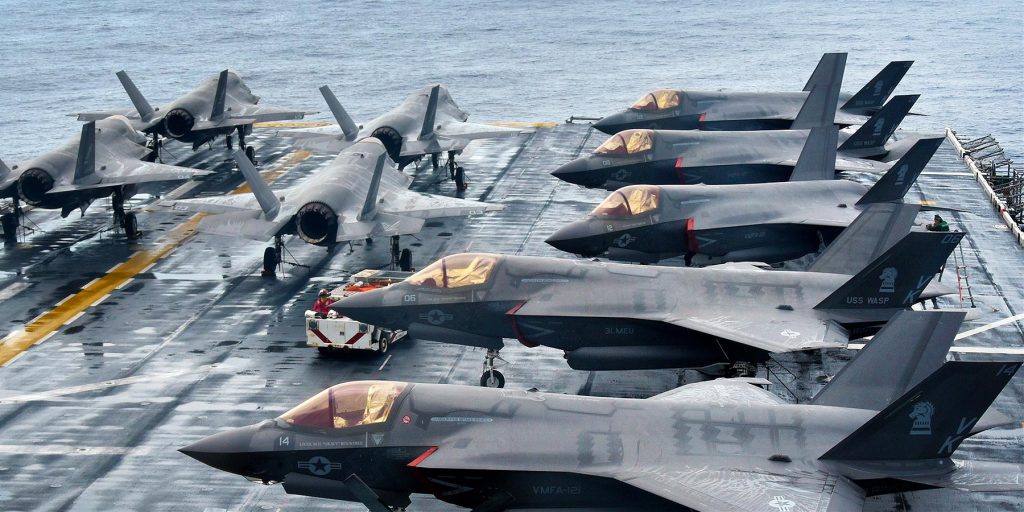The Izumo Class Modification: A Game-Changer in Western Pacific [English]

Ilustrasi Kapal dan Pesawat Tempur Jepang. Foto: navalnews.com
In recent years, Japan has been ramping up its defense capabilities against potential threats in the region by building up and acquiring various weapon systems in order to ensure the protection of its territory and sovereignty. From launching a new class of AEGIS-capable destroyers, developing new long-range anti-ship missiles, forming an amphibious infantry brigade, to buying a fleet of F-35 Lightning II, a fifth-generation stealth fighter (IISS, 2018). All in all, it seems clear that Japan is slowly inching ever further from its own principle to never claim the right of belligerency or maintain an armed force under Article 9 of the Japanese Constitution, even though they have to side-step the legal definitions contained within. One of the most controversial application of such method is the launching of the Izumo Class helicopter destroyers, a 27.000 ton ship with a full-length, 248 meter flight deck, a flight control island, and two elevators (Radford, 2013). It is the biggest warship Japan has ever made since the days of World War II aircraft carriers. And it does resemble a carrier in all but name. The Japanese Constitution forbids the Japanese Self-Defense Force (JSDF) from fielding offensive weapons, a fact that led Japanese officials to classify it as a multi-purpose operation destroyer rather than a carrier, and to be used in national defense specifically in anti-submarine warfare, border-area surveillance missions, and to help respond to large scale natural disasters (Associated Press, 2013).
Nevertheless, for countries in Western Pacific that still have some historical animosity towards Japan, the vessels raised some concern about its potential to be used as a power projection platform for Japanese forces. Especially China, who urged Japan to act carefully and respect the principle of “peaceful development”. But the fact at hand is that the Japanese built these ships specifically as a response against the rising blue water capability of the People’s Liberation Army Navy (PLAN), who is currently building a carrier task force capable of even challenging the U.S. Navy. Their second carrier, Shandong, was commissioned last year, and they are projected to have five to six carriers by 2030s (Childs, 2018). It is no surprise then that Japan won’t back down so easily if they have to face such a future, even more so since at present both Japan and China are in a dispute regarding a chain of islands in the East China Sea, in which China claimed it as their own by calling it Diaoyu Islands and Japan naming it as Senkaku Islands. With the area estimated to have potentially vast gas and oil fields off its shores, it makes sense why both sides are keen to strengthen their claims by showing off their power projection capability that best manifested in the form of carriers (Bana, 2015).
Just as the potential threat keeps rising, so does the willingness to counter it. On 18 December 2018, the Japanese government announced that it will start to refit the Izumo-class and buy 42 F-35Bs (Lendon & Wakatsuki, 2018). This wasn’t a big surprise. Although originally intended to only operate anti-submarine warfare (ASW) helicopters like the SH-60K/J from its deck, there were indications that the ships could also support V-22 Osprey and F-35B Lightning II based on its design features. Back then, Japanese officials tried their best to deny the possibilities of operating fixed-wing short take-off and vertical landing (STOVL) aircrafts from Izumo Class’s deck (Cannon & Rossiter, 2019). But the fact that since the end of June 2020, the ships have been undergoing modifications at the Japan Marine United (JMU) Corporation’s Isogo shipyard in Yokohama, makes it clear that the Japanese will make sure it can guarantee its own safety (Takahashi, 2020).
When completed, the Izumo Class will truly be a game-changer not only for Japan, but also for the situation in Western Pacific. Because then the Japanese Air Self Defense Force (JASDF) will be able to fully exploit the unique capabilities from the F-35B. The B variant of the F-35 can launch from short airstrips, makeshift runways, and land on austere environments, perfect for geographic conditions in Western Pacific, where there are plenty of small islands that would be contested in times of war. Add to the fact that conventional runways will be at risk during conflict, the combination of F-35B and the Izumo Class means that the JASDF can survive attacks from its foes by dispersing its forces and be able to conduct high-end fighter sorties using the stealth and electronic capabilities delivered by fifth-generation aircraft. It can act as a force multiplier by enhancing the overall flexibility of the JSDF and allows it to effectively defend its vulnerable territories, including the disputed southernmost islands of Senkaku (Rogoway, 2018). Not only that, the conversion will also be beneficial to Japan’s allies because it could increase interoperability between the JSDF and other forces, notably the United States Marine Corps. Since USMC also operate F-35Bs and deploy similar ships in the region, like the Wasp-class, they could theoretically land on each other’s ships, significantly adding an element of distributed lethality to an already potent weapon system. Even Japan’s former Defense Minister Takeshi Iwaya stated, “There may be no runway available for the US aircraft in an emergency. I cannot say that the US F35B should never be placed on an [JMSDF] escort vessel,” confirming the possibility of such cooperation (Vavasseur, 2019).
In short, the modification of the Izumo Class marked a new direction in which Japan may involve itself in the region. Whether it be to enhance ties between allies, deter enemies, or project power, the Izumo-class, with the F-35B, will be a powerful combination ready to secure Japan’s interest and defend its sovereignty.
References
Associated Press. (2013, August 6). Japan unveils new carrier-like warship, largest in navy since WWII. Fox News; Fox News. https://www.foxnews.com/world/japan-unveils-new-carrier-like-warship-largest-in-navy-since-wwii
Bana, S. (2015). Sea Power: The Rise of the Aircraft Carrier in the Asia-Pacific. World Affairs, 178(3), 43–50. JSTOR.
Cannon, B., & Rossiter, A. (2019). Offensive or Defensive: The Debate over Japan’s “Aircraft Carrier” Upgrade (SSRN Scholarly Paper ID 3463696). Social Science Research Network. https://papers.ssrn.com/abstract=3463696
Childs, N. (2018, June 3). China’s carrier-aviation developments: Making a difference. IISS. https://www.iiss.org/blogs/military-balance/2018/06/china-carrier-aviation-development
IISS. (2018). The Military Balance 2018: The Annual Assessment of Global Military Capabilities and Defence Economics. International Institute for Strategic Studies, 2018. https://www.iiss.org/publications/the-military-balance/the-military-balance-2018
Lendon, B., & Wakatsuki, Y. (2018, December 18). Japan to have first aircraft carriers since World War II. CNN. https://www.cnn.com/2018/12/18/asia/japan-aircraft-carriers-intl/index.html
Radford, P. (2013, August 13). The ship that dare not speak its name. Australian Strategic Policy Institute. https://www.aspistrategist.org.au/the-ship-that-dare-not-speak-its-name/
Rogoway, T. (2018, February 27). Officials Admit Japan’s “Helicopter Destroyers” Were Also Designed For Jets. The Drive. https://www.thedrive.com/the-war-zone/18855/officials-admit-japans-helicopter-destroyers-were-also-designed-for-jets
Takahashi, K. (2020, June 30). Japan begins refitting first of two Izumo-class carriers to support F-35B operations. Janes.Com. https://janescom.sitefinity.cloud/defence-news/news-detail/japan-begins-refitting-first-of-two-izumo-class-carriers-to-support-f-35b-operations
Vavasseur, X. (2019, August 21). USMC to Fly First F-35B from Japan’s Izumo-class Aircraft Carriers. Naval News. https://www.navalnews.com/naval-news/2019/08/usmc-to-first-fly-f-35b-from-japans-izumo-class-aircraft-carriers/
M. Damar Shafy Ramadhan is an undergraduate student in International Relations, Gajah Mada University





